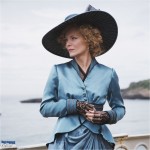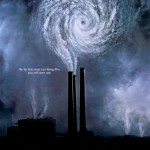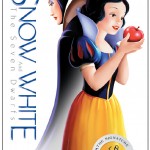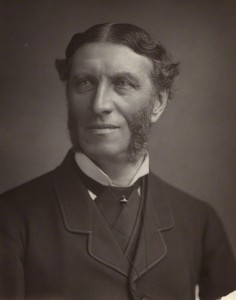
Perhaps the most unfortunate thing about Culture and Anarchy, Matthew Arnold’s series of essays that were later collected together as a book, is the title. No matter how many times I tell students–and I do–“Thus will be on the test,” the title makes them think that “culture” is the opposite of “anarchy.” Actually, Arnold sets up “tyranny” as the opposite for “anarchy.” Culture, he suggests famously, is “the best which has been thought and said.” Tyranny is when people have no freedom; anarchy results when there is all freedom and no commitment. In the wake of the reform bill of 1867, Arnold wondered how it would be possible to mold new voters–who may not have been raised with any values except a passionate belief in the freedom to do whatever one wants–into productive citizens operating out of some sort of civic principle other than plain, old fashioned selfishness.

The point is that–for Arnold at least–anarchy is not a corrective for tyranny. Anarchy is an equally bad state, one as damaging as the state of tyranny (though others may not agree with him on that) and thus to be avoided. Culture is a means to an end–that of making citizens see and understand that there is something bigger than themselves and their freedoms. There are other ways of enculturating citizens besides training them to value and appreciate art. Arnold noted that military conscription was a very effective way. He also noted, though, that a citizenry more committed to and in love with the freedom to do whatever it wants rather than the freedom from being tyrannized is likely to see conscription as a fundamental violation of its entitled freedom rather than as a living classroom in which it can learn the values of those freedoms. (Almost exactly a century later, Robert Heinlein would grapple with the same problem in Starship Troopers; he posited a world in which citizenry was not a birth right but had to be earned through service.)
Culture in V for Vendetta–James McTeague’s 2005 film adaptation of the Alan Moore Graphic novel (with a screenplay by the Wachowski brothers)–is something a little different. Audience surrogate Evie (played by Natalie Portman) first meets V, a revolutionary in a Guy Fawkes mask, when he is rescuing her from an act of personal violence. When she subsequently helps him escape a tight spot while he is attacking the television station where she works, he takes her away and she wakes up in his hidden lair. She awakes to the sound of a jukebox playing forbidden jazz and wanders through a room of stolen art treasures. As if to underscore the growing fascist nature of the British government and its similarities to the regime of Nazi Germany, we are told these classic works of art are not cherished artifacts of culture but “objectionable materials” that the government has seized and censored.
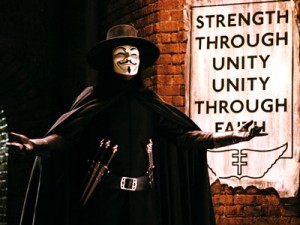
These objects have value, then, in part at least because they express ideas…ideas the government wants people to reject or to think of as wrong. They are not instrumental, though, in the dissemination or preservation of these ideas. The William Tell overture conveys the idea, one thinks, that the rush of exhilaration one feels when watching something blow up is linked to the sensory experience of it rather than the meaning of it. I digress, though. The artifacts are a badge, a signpost. V is a good guy because he likes art and culture. The government is bad because it bans it. (Or some of it, we aren’t really told which.)
This is not the only place in which V sounds cool but is–dare I say it?–a bit hard to follow through to a coherent point. Words and ideas are the most powerful, life changing things, but they are championed by a masked guy who gets his message out by blowing stuff up. The people to whom he appeals are complicit in their own enslavement, but they will respond to sudden, violent freedom from oppression not by turning on one another but by practicing responsible, self-controlling representational government:
Because while the truncheon may be used in lieu of conversation, words will always retain their power. Words offer the means to meaning, and for those who will listen, the enunciation of truth. And the truth is, there is something terribly wrong with this country, isn’t there? Cruelty and injustice, intolerance and oppression. And where once you had the freedom to object, to think and speak as you saw fit, you now have censors and systems of surveillance coercing your conformity and soliciting your submission. How did this happen? Who’s to blame? Well certainly there are those more responsible than others, and they will be held accountable, but again truth be told, if you’re looking for the guilty, you need only look into a mirror. I know why you did it. I know you were afraid. Who wouldn’t be? War, terror, disease. There were a myriad of problems which conspired to corrupt your reason and rob you of your common sense. Fear got the best of you, and in your panic you turned to the now high chancellor, Adam Sutler.
V, like Matthew Arnold, thinks the average commoner poor stock from which to breed responsible, engaged citizens. Or, rather, Arnold thinks they may have potential, but he doesn’t trust their ability to spontaneously form, maintain or recreate that government without any prior preparation or learning. This tension between the belief in the average man’s (and woman’s) inherent goodness and the need to explain the horrible state the world is in is not uncommon in post-romantic American and English fiction. The resolution–one that I find unsatisfying–is usually making evil institutional. There are no bad people, just bad systems. Or, perhaps, there are a few bad people, and the bad systems are those that allow the small minority to oppress the benign majority. Hence, we are able to hold onto the belief that the best way to liberate people is to raze the oppressive structure(s) that reinforce the corrupt minority. From the vacuum that follows, a more benign, enlightened structure will emerge that reflects the goodness of the people who have learned their lessons.
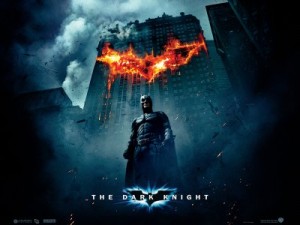
I’m tempted to call this the “Dark Knight” theory of anarchy, since one of my first encounters of it was in Frank Miller’s graphic novel The Dark Knight Returns, and because Christopher Nolan’s film of the same name seems to embrace the same squishy logic. Dan Mohr wrote of that film:
We have to watch minute after minute of prisoners and civilians on two different ferries decide whether or not to detonate explosives rigged to the others’ boat, and linger over their “screw everyone else, I’m totally in it for myself” rottenness (and *no one* on either ferry stands up in protest and says, “stop these madmen!”) — but oh yeah, then the prisoner decides to throw the detonator out the boat window, and the civilian decides he doesn’t have the heart to go through with it — so you see, the moviemakers finally demonstrated to us that these people REALLY aren’t rotten after all, even though they’ve just forced the audience to deal with five straight minutes of odious human nature.
To this observation, I could not help adding that five minutes after we get Batman telling the Joker that the people will do the right thing (“there will be no explosion”) we get Batman telling Gordon that the people will be so crushed that their hero, Dent, isn’t perfect, that they have to construct this elaborate lie about Batman in order to keep them from spiraling into the pointless anarchy the Joker is trying to foster.
If Batman, like V, has contradictory notions about the people he is trying to liberate from tryanny, the real cult hero of the film, Heath Ledger’s Joker, expresses the Milleresque trope that civilization weakens rather than strengthens its occupants because it places limitations only on good people, not on those who ignore them. (This is the theory equivalent of the maxim that if you outlaw guns only outlaws will have guns, writ large.) “You have all these rules, and you think they’ll save you.” The Joker, like V, sees violence as a rational alternative to corruption and decay, but his motivation is sadistic rather than prophetic–he is destroying the old not to prepare the way for a renaissance and rebirth but because he finds the anarchic state more pleasurable for the tyrants and sadists.
In George Orwell’s “Shooting an Elphant,” the autobiographical narrator speaks, prophetically, about his own secret desire for violence fed by his hatred of tyranny. Yet his words are laced with a hard irony: “I was young and ill-educated and I had had to think out my problems in the utter silence that is imposed on every Englishman in the East. I did not even know that the British Empire is dying, still less did I know that it is a great deal better than the younger empires that are going to supplant it.” In the twentieth century, opposing tyranny without building democracy is seldom enough. You can’t just blow up the tyrant. The vacuum creates not a peaceful sea resulting in a more stable ship of state but rather a tempestuous maelstrom in which, perhaps, a worse tyranny emerges to prey on a yet weaker populace.
[In part two: is anarchy always violent?]


